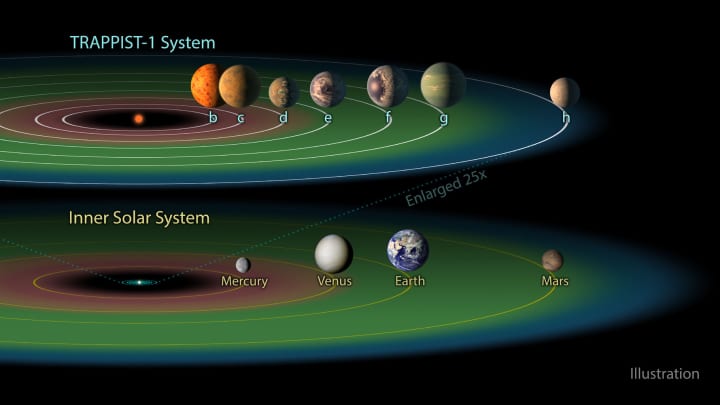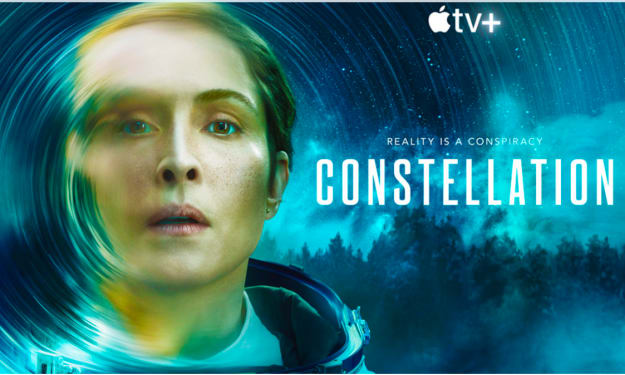Could the TRAPPIST-1 Planetary System Be Home to Alien Life?
New James Webb Space Telescope will examine atmospheres of seven Earth-sized exoplanets.

The discovery of seven Earth-sized planets orbiting the star TRAPPIST-1 generated a lot of excitement last week. Earth-sized planets have been found before, among the thousands of exoplanets discovered so far by astronomers, but this is the first time that so many have been detected in one planetary system. As of now, astronomers are limited in how much they can learn about these new worlds, but the James Webb Space Telescope, the upcoming successor to Hubble due to launch in 2018, will be able to gather more data and analyze whatever atmospheres these planets have, perhaps bringing us closer to finding another habitable world.
JWST will be able to examine the atmospheres of these planets, if they exist, and determine whether they contain possible bio-markers such as oxygen, methane, or water.
According to James Webb Program Director Eric Smith, when JWST looks at one of the planets, “What [the JWST] will do is determine what are the major components of the planet’s atmosphere,” Smith says. “If it has a lot of water, a lot of oxygen, a lot of methane, it will be able to find those things in the atmosphere. We can see if it has an atmosphere similar to Earth or different from Earth.”
“It’s very exciting to see the data bearing out the suspicions astronomers had for a long time,” Smith told Inverse. “It’s not the matter of if we’ll discover an Earth-like planet in a habitable zone, it’s when. In a system that’s relatively nearby, that’s exciting.”
Comparison of rocky worlds in TRAPPIST-1 and our own Solar System

Artist’s conception of the seven known Earth-sized planets in the TRAPPIST-1 system, compared to the inner planets of our Solar System. Image by NASA/JPL-Caltech
As Smith also noted, “We won’t be able to detect that life with JWST, but I think that would be a tremendous discovery in and of itself to say, ‘that place could have life.’”
“This discovery could be a significant piece in the puzzle of finding habitable environments, places that are conducive to life,” said Thomas Zurbuchen, associate administrator of NASA’s Science Mission Directorate in Washington. “Answering the question ‘are we alone’ is a top science priority and finding so many planets like these for the first time in the habitable zone is a remarkable step forward toward that goal.”
The seven planets all orbit very close to their star, but at least three of them lie within the star's "habitable zone" where temperatures could allow liquid water on their surfaces. This is because the star, TRAPPIST-1, is a dwarf star, much smaller and cooler than our own Sun - only slightly larger than Jupiter. Whether any of these planets do have water, however, depends on other surface and atmospheric conditions as well, which are all unknown at this point.
As noted in the ESO press release, “The energy output from dwarf stars like TRAPPIST-1 is much weaker than that of our Sun. Planets would need to be in far closer orbits than we see in the Solar System if there is to be surface water. Fortunately, it seems that this kind of compact configuration is just what we see around TRAPPIST-1!”
Comparison of inner planets in TRAPPIST-1 and our own Solar System

Illustration comparing the TRAPPIST-1 system with the inner planets of our Solar System. Image by NASA/JPL-Caltech
“This is a tremendously exciting possibility for the JWST, and we most certainly will observe this system, but it’s also part of a long chain of astronomy and telescopes improving upon one another,” Smith said. “Even though it will be the biggest [telescope] put out into space, we know it won’t be the last because there will be more questions to ask.”
“This discovery could be a significant piece in the puzzle of finding habitable environments, places that are conducive to life,” said Thomas Zurbuchen, associate administrator of the agency’s Science Mission Directorate in Washington. “Answering the question ‘are we alone’ is a top science priority and finding so many planets like these for the first time in the habitable zone is a remarkable step forward toward that goal.”
All seven planets may be tidally locked, meaning that the same side of the planet is always facing the star, much like how the same side of the Moon always faces the Earth. If so, there could be strong effects on weather systems, such as strong winds blowing from the day side to the night side or extreme temperature changes.
The seven planets are also quite close to each other, and would appear about the same size or larger than our Moon in each other’s skies. It’s the kind of thing that science fiction stories are made of.
TRAPPIST-1 travel poster

Welcome to TRAPPIST-1e – what would a trip there be like? Image by NASA-JPL/Caltech
It has also just been reported that the habitable zone in the TRAPPIST-1 system might be larger than previously thought, thanks to volcanic hydrogen (H2) as a potential climate-warming greenhouse gas. If any of the planets have H2 in their atmospheres, it could help them to remain habitable in more distant orbits. The researchers found that H2-rich atmospheres could expand the habitable zone by as much as 30 to 60 percent.
“Where we thought you would only find icy wastelands, planets can be nice and warm - as long as volcanoes are in view,” said Lisa Kaltenegger, co-author of the new study.
Earth-sized exoplanets are now thought to be common, with probably billions in our galaxy alone; with the discovery of seven such worlds orbiting a single nearby star, scientists are now even closer to finding another habitable world and, perhaps, the first evidence for the ultimate goal - extraterrestrial life.
As noted by Michaël Gillon of the STAR Institute at the University of Liège in Belgium, “The story is just beginning.”
The new findings were published Feb. 22 in the journal Nature.
About the Creator
Paul Scott Anderson
Paul is a freelance space writer and blogger who currently writes for AmericaSpace and Vocal. His own blog Planetaria is a chronicle of planetary exploration.
paulscottanderson.ca
planetaria.ca






Comments
There are no comments for this story
Be the first to respond and start the conversation.